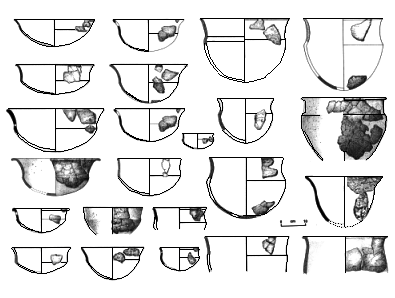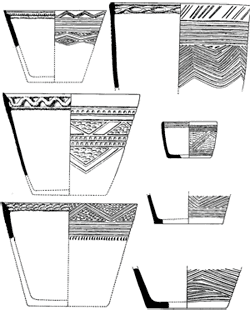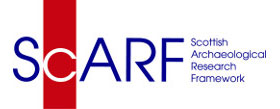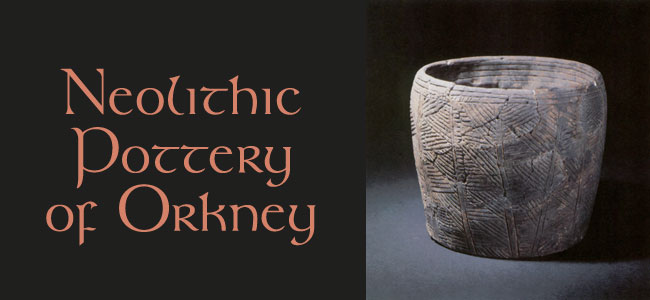
Broadly speaking, there were two distinct ceramic traditions in Orkney during the Neolithic— round-bottomed, carinated bowls, some of which bore incised decoration, and flat-bottomed bowls and jars with deeply incised decoration.
Unstan Ware has generally been associated with settlements and tombs belonging to the Early Neolithic and Grooved Ware with the Late. It was believed that they represented successive groups of immigrants, the one replacing the other. Recent excavations at Pool (Sanday) and revisions to the chronology of Neolithic Orkney have shown that the transition was a gradual one and that both styles overlapped for a long time.
Unstan Ware (Carinated Bowls)
Unstan Ware is actually a local development of a much broader tradition of Carinated Bowls that appears to have developed in the Pas de Calais region of north-eastern France and was part of the cultural baggage of some of the first groups of immigrant farmers to arrive in Britain around about 4000 BC. Another major strand, found predominantly along the Atlantic seaboard, apparently has Breton origins.
Carinated Bowls first appear in south-east England, across the Straits of Dover, and then spread throughout lowland Britain and up the North Sea coast to Caithness and then to Orkney. They are invariably round-bottomed, which makes it easy to set them on the bare ground or in the ashes of a hearth, and come in a wide variety of shapes ranging from shallow to deep bellied bowls (opposite right). This was no doubt determined by their function— storage vessels, cooking pots or dinner service. Some, but not all, of them have a pronounced break (“carination”) in their profiles. Aside from any aesthetic considerations, the shape of the vessels made them easier to handle and less likely to drop.
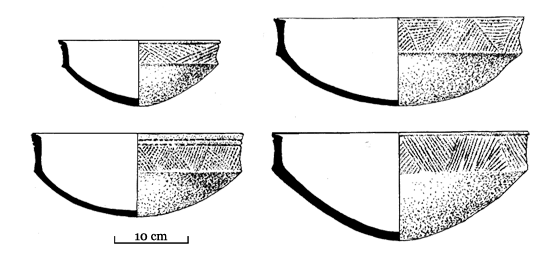
Unstan Ware is a finer, more decorative variant of Carinated Bowl and it is difficult not to see it as a special-purpose type of vessel, perhaps used on ceremonial occasions. It consists in the main part of shallow bowls bearing incised geometric patterns, most commonly herringbones or triangles, in a band above the break in their profile. Unstan Ware has been found among the carinated vessels of Caithness and may have been part of the cultural baggage of the first Orcadian farmers.
Grooved Ware
While Carinated Bowls (and ultimately Unstan Ware) have there origins elsewhere, radiocarbon dates seem to indicate that Grooved Ware vessels were a native Orcadian innovation and spread from there throughout the rest of Britain, notable appearing at some of the large henge monuments in the south, such as Durrington Walls in Wiltshire. It was this widespread distribution that led Stuart Piggott to label it ‘Rinyo-Clacton’ ware (after two sites, one in Orkney and the other at the mouth of the Thames in  Essex).
Essex).
The predominant form is a flat-bottomed bowl or jar with slightly flared sides and comes in a wide range of sizes, ranging from hand-held drinking vessels up to much larger buckets and basins. As the name implies, the most ‘typical’ style of decoration consists of incised patterns, mainly geometric, ranging from simple hatching to elaborate patterns,  such as on this sherd from Skara Brae (left). However, as time went by, applied and painted decoration become become more prominent elements in the final design (right).
such as on this sherd from Skara Brae (left). However, as time went by, applied and painted decoration become become more prominent elements in the final design (right).
Julian Thomas has suggested that the patterns derive from the decoration found at the great passage graves of the Boyne Valley in Ireland, which was a major cultural and religious centre at the time and no doubt attracted visitors from Orkney and elsewhere. They are mainly found around the perimeter of the tombs and would appear to mark the transition from the world of the living to the world of the dead. The Irish passage grave tradition is certainly reflected in the construction of Maes Howe but in Orkney the designs appear on the pottery rather than the architecture. 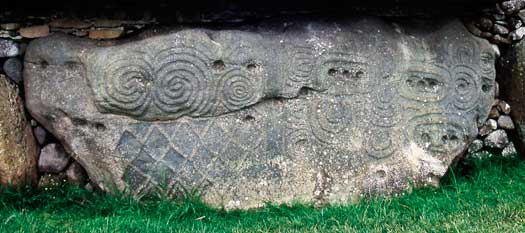
Kerbstone of the passage grave at Newgrange in the Boyne Valley, Ireland
It has been suggested that they would have been very suitable for the production and consumption of beer and traces of cereal residue have been found on large Grooved Ware vessels elsewhere in Scotland. The consumption of intoxicants has marked life’s important transitions since time immemorial and continues to this day at weddings and wakes.
Suggested Reading
| Card, Nick | (2017) | To Cut a Long Story Short: Formal Chronological Modelling for the Late Neolithic Site of Ness of Brodgar, Orkney. European Journal of Archaeology |
| Davidson, A.L. & A.S. Henshall | (1989) | The Chambered Cairns of Orkney |
| Dineley, Merryn | (1999) | Barley, Ale and Malt in the Neolithic. BAR S1213. |
| Piggott, Stuart | (1954) | Neolithic Cultures of the British Isles |
| Renfrew, Colin (ed.) | (1985) | Prehistoric Orkney |
| Richards, Colin & Richard Jones (ed.) | (2016) | The Development of Neolithic House Societies in Orkney |
| Sheridan, J.A. | (2007) | From Picardie to Pickering and Pencraig Hill? New information on the 'Carinated Bowl Neolithic' in northern Britain. Going Over: The Mesolithic-Neolithic Transition in North-West Europe. (edit. Whittle, A. & V, Cummings) |
| Thomas, Julian | (2010) | The Return of the Rinyo-Clacton Folk? The Cultural Significance of the Grooved Ware Complex in Later Neolithic Britain. Cambridge Archaeological Journal, Vol. 20 |
Internet Resources

